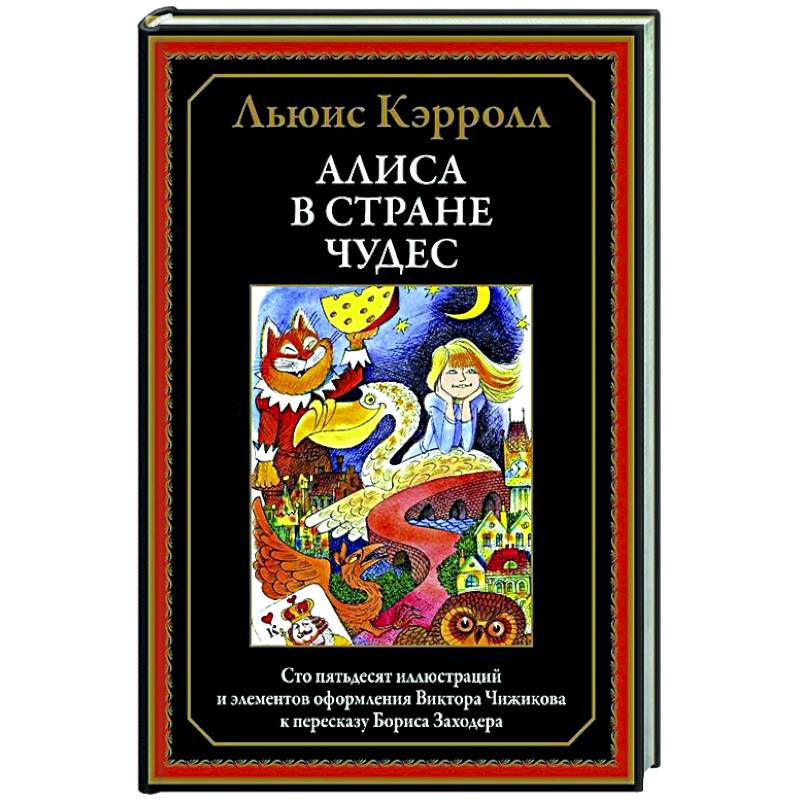Alice in Wonderland
Please sign in so that we can notify you about a reply
The text of the famous novella by Lewis Carroll, "Alice in Wonderland," is given in the author's retelling by Boris Vladimirovich Zakhoder. The edition begins with a foreword by the translator. The book is magnificently illustrated with color drawings and monochrome frontispieces by the People's Artist of the Russian Federation, Viktor Alexandrovich Chizhikov. At the end of the book, black-and-white versions of his drawings for this novella, which were printed in the magazine "Pioneer" in 1971-1972, are presented.
It's hardly necessary to introduce Lewis Carroll to readers. His story about Alice's adventures has been translated into more than a hundred languages of the world. There are even special studies on the peculiarities of translating his books into national languages, as this is a very difficult task. Carroll's text is saturated not only with witticisms, puns, and verbal paradoxes but also with poetic parodies of verses known in his time. Therefore, a literal translation of "Alice" would be incomprehensible or overloaded with comments, and too free a translation risks straying far from the original and losing the English national color. Attempts to "Russify" Carroll have been made. In 1879, an anonymous retelling - "Sonya in the realm of wonder" was printed. In it, all English realities were replaced with Russian ones. For example, the Mad Hatter turned into Ilyushka-the-liar. In Nabokov's translation, published in 1923, Alice became Anya, and the Cheshire Cat - Maslenitsa. Against this background, the translation by Demurova is classic and closest to the original. Not surprisingly, it was published in 1977 in the academic series "Literary Monuments." And yet, as Demurova herself noted, "it is impossible to accurately convey concepts and realities that do not exist in this other language."
Therefore, every translation of Carroll's text has its merits and demerits. The translation by the remarkable writer and poet Boris Vladimirovich Zakhoder published in this book has many merits. He made Carroll's book understandable for schoolchildren, enriching it with Russian-language puns. Having cried a whole sea of tears, Alice finds herself in a sorry state, and to her remark about wanting to have a good time, the Hat (Mad Hatter) replies: "You can't spend time." Zakhoder has many such puns, thanks to which the whimsically quirky spirit of Carroll's fairy tale is preserved. Zakhoder's translation, published in 1971-1972 in the magazine "Pioneer," was illustrated with magnificent drawings by Viktor Alexandrovich Chizhikov. In this edition, they are presented in color. Chizhikov's sparkling talent adds additional colors to Carroll's story. Alice and almost all the other characters of the fairy tale, unlike the classic drawings by Tenniel, often smile. Chizhikov constantly plays along with Zakhoder. For example, he depicts the Fish Delicacy as a sturgeon with an empty caviar can on its head. In his drawings, in the lesson schedule, drawing, thanks to a crossed-out letter, turns into spinning, and history - into hysteria. It's pleasant when two talents work on a book together. Happy reading!
Author:
Author:Carroll L.
Cover:
Cover:hardcover
Category:
- Category:Fiction
- Category:Poetry & Literature
Publication language:
Publication Language:Russian
Paper:
Paper:offset
Dimensions:
Dimensions:25x18x1.5 cm
Series:
Series:Library of World Literature
Product type:
Product type:embossing, gold embossing, partial lacquering
ISBN:
ISBN:978-5-9603-0904-2
No reviews found
